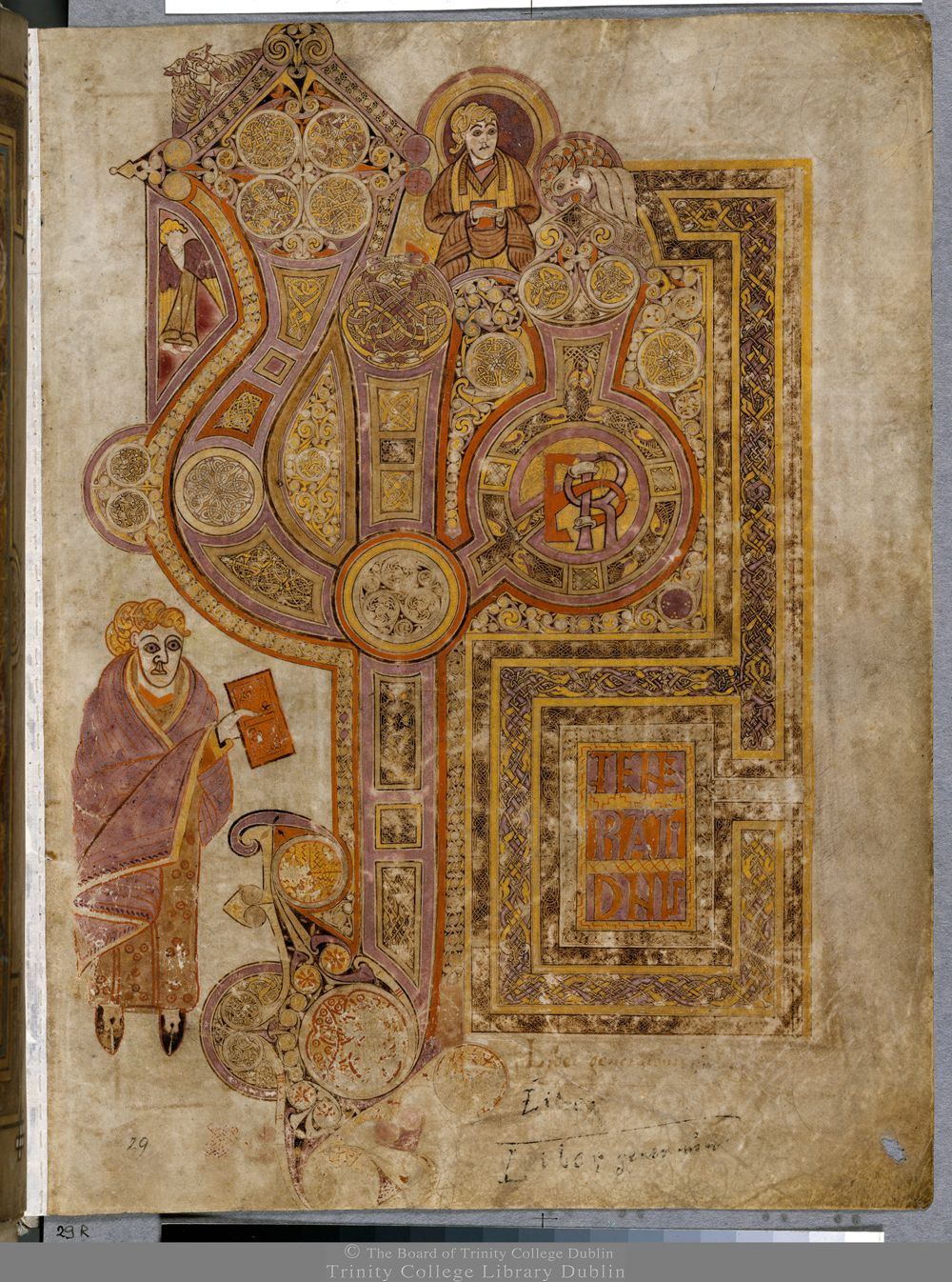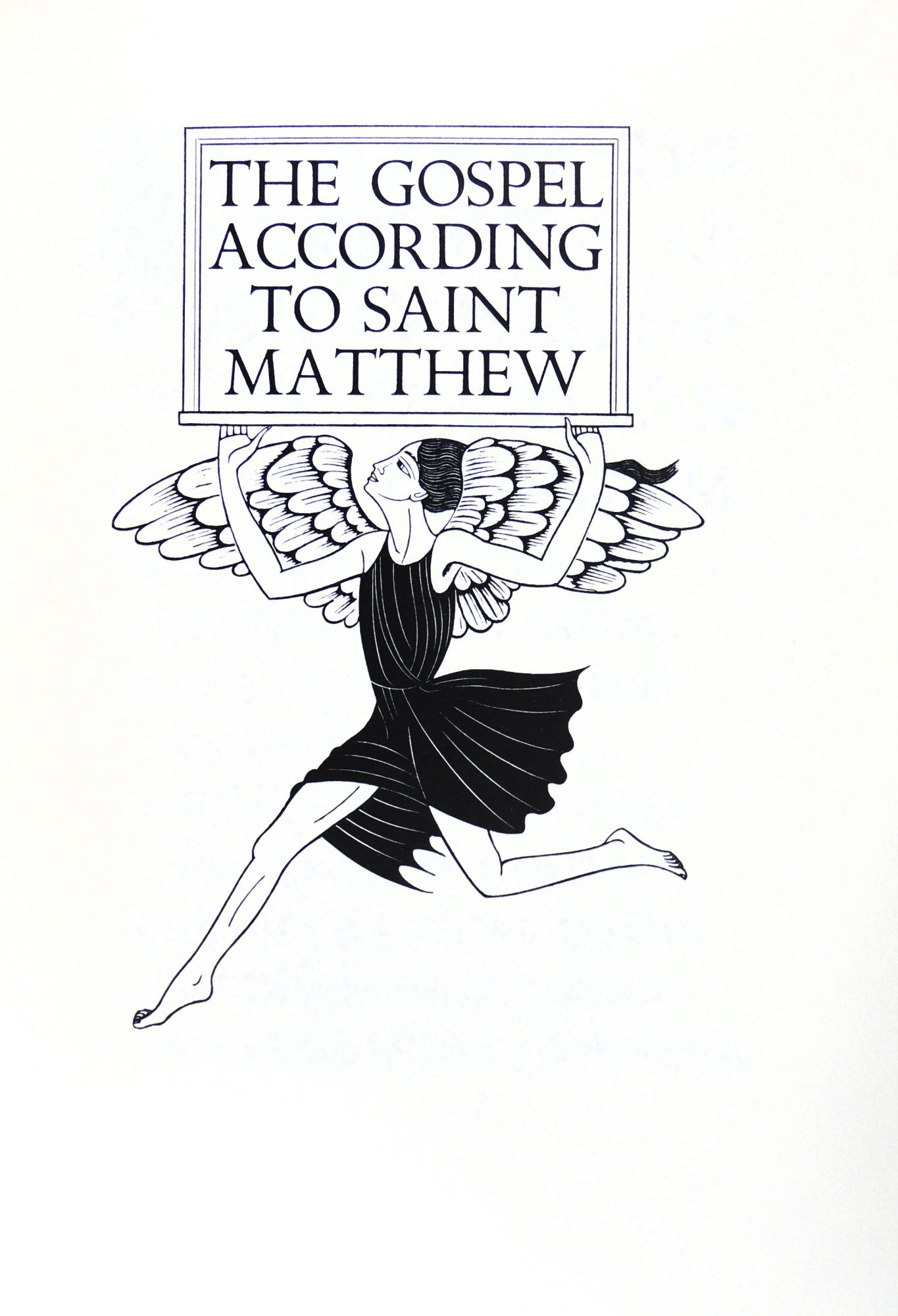Depicting the Genealogy of Christ
The Depiction of the Genealogy of Christ from the Middle Ages to the Private Press Movement
By Corlis FRAGA and Alice FOURNIER
Project Synopsis
In the following discussion, we will examine how the “Book of Matthew” in different editions of the New Testament is presented. Specifically, we will evaluate the Book of Kells and The four Gospels of the Lord Jesus Christ according to the Authorized Version of King James I with decorations by Eric Gill. The goal is to analyze and compare the relationship between the images and the text in each edition to expose potential iconographic similarities.
| Bible #1 | Bible #2 | |
| Title | The Book of Kells | The four Gospels of the Lord Jesus Christ according to the Authorized version of King James I with decorations by Eric Gill |
|---|---|---|
| Date | c. 800 | 1931 |
| Place | Iona, Scotland | Berkshire, England |
| Contributor(s) | Translator: [St. Jerome] Scribe: Multiple, Unattributed | Translator: Multiple, Unattributed. Artist: Eric Gill (1882-1940) Printer: Robert Gibbings (1889-1958) |
| Language(s) | Latin, Vulgate; Irish | English, King James Version |
| Source | Trinity College Dublin, IE TCD MS 58 | Saint Louis University Libraries, BS2553 .A3 1931 |
| Format | 340 f., 330 x 255 mm | [4] ff., 268 pp., [4]., 35 cm |
Introduction to The Book of Kells
The Book of Kells is an illuminated manuscript held as a prime example of Insular art and Celtic Christianity. It is widely believed to have been created circa 800 C.E. at the Scriptorium of Iona. The book is composed of the Gospels in Latin, along with a diverse range of accompanying charts and intricate illustrations. The illustrations are renowned for their detailed designs, vivid colors, and intertwining patterns incorporating Christian and Celtic symbolism. The Book of Kells serves as a significant cultural and historical artifact, symbolizing the artistry and religious devotion of the early medieval period.
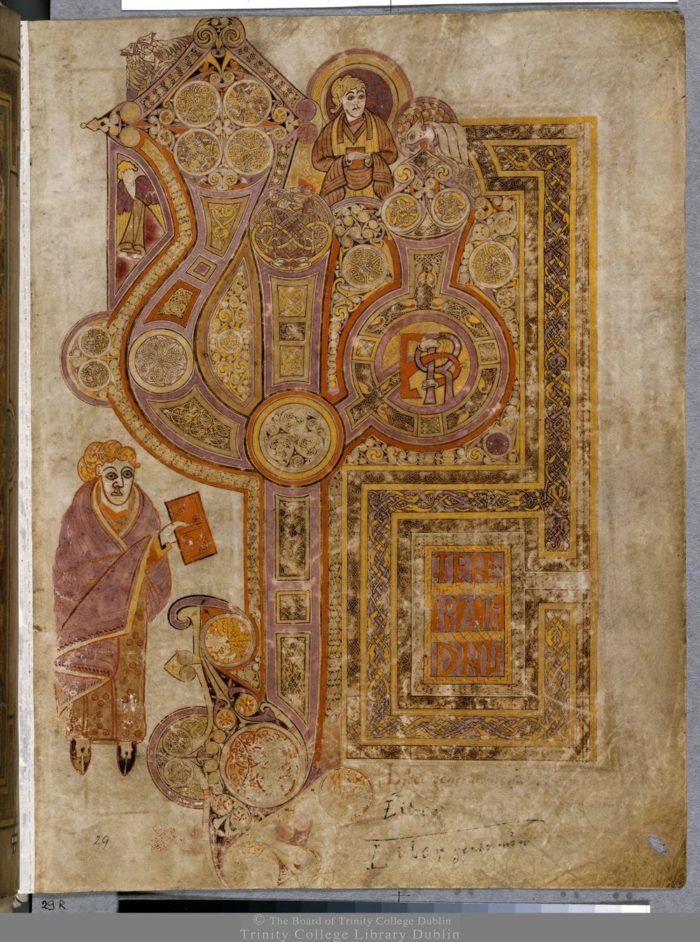
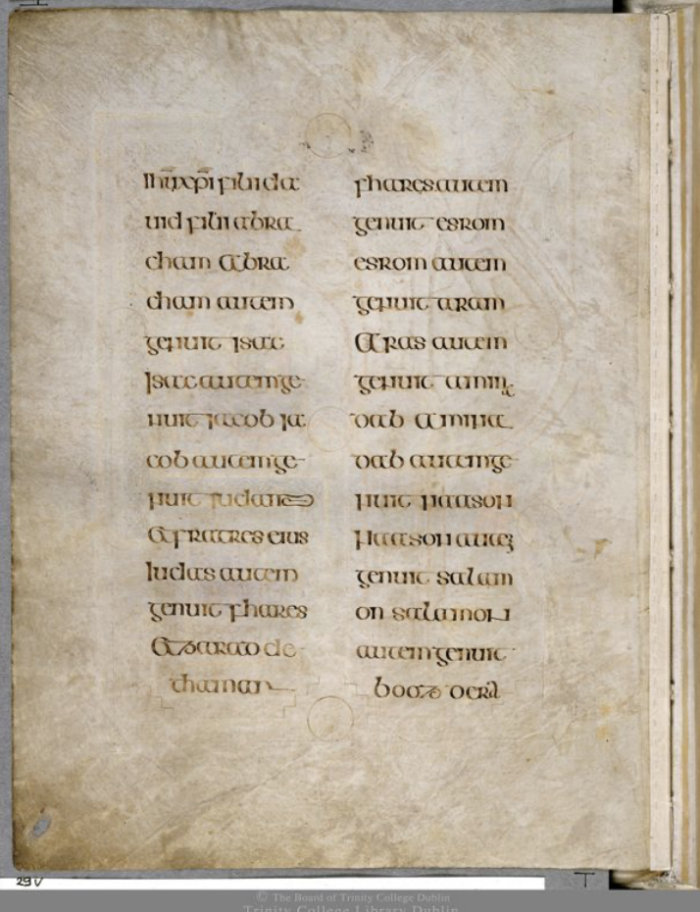
Analysis
Illustration evaluation
The frontispiece of the Liber Generationis is a full-page illustration, reprising the motif already found in the Gospels of Lindisfarne.1 The scribes behind the Book of Kells used colors in a specific way, weaving them into the text with a mastery that was novel at the time of its creation. And weave them into the text, they did. In the case of the title page of the Liber Generationis, the text becomes the image, and vice-versa: less structurally divided than its companion in the Lindisfarne edition, the giant Liber stands as one letter (“L”), all intricate weavings, knots, and curves.
The Significance
The interest in the Book of Kells as an object is a relatively recent cultural development. According to Stalley, the manuscript only became accessible to the larger public in the mid-19th century, but only gradually became known as a symbol of Irish artistry.2 As such, in terms of political or cultural significance throughout the earlier stages of its history, little is known or recorded, suggesting that it remained mostly behind closed doors prior to its arrival at Trinity College.
Introduction to The Four Gospels
The four Gospels is a numbered limited edition (500 copies) published in 1931 presenting the four Gospels of Matthew, Mark, Luke, and John. The text adheres to the linguistic and literary style of the King James Version, a highly influential and widely used English translation of the Bible, with typographic embellishments and illustrations by Eric Gill, a renowned British typeface designer. It is a fusion of spiritual and artistic excellence, aiming to offer readers a deeper appreciation of the sacred scriptures.
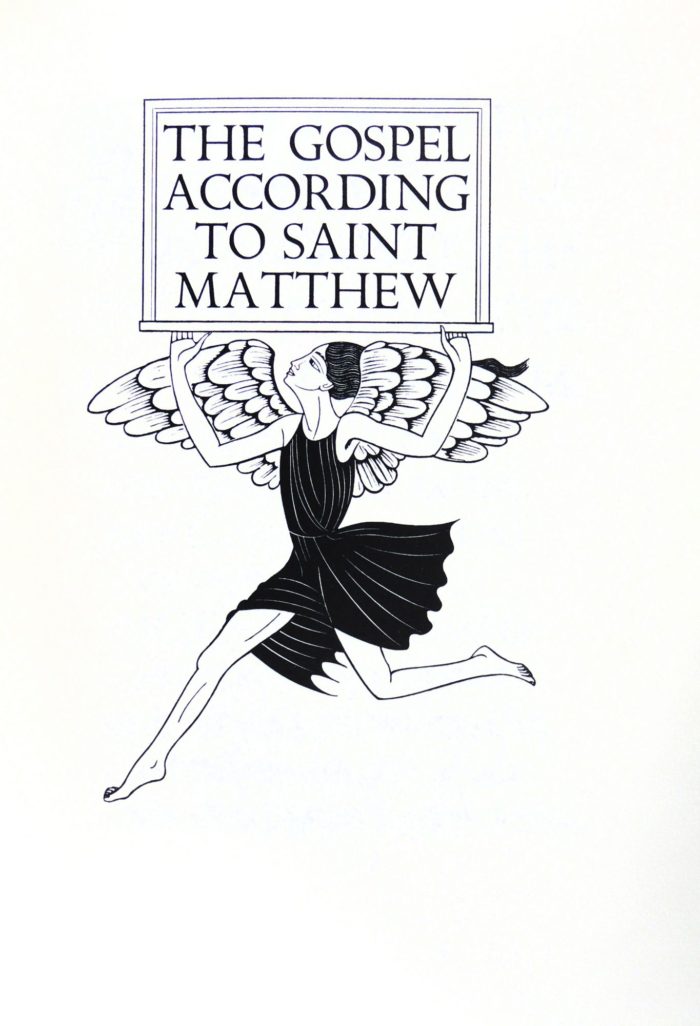
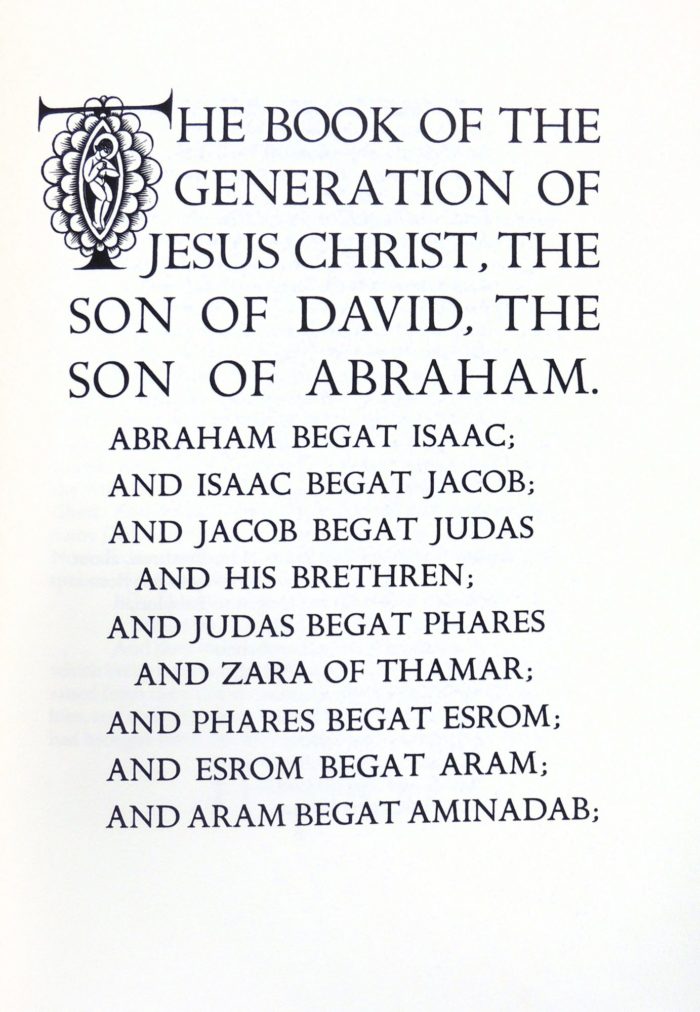
Analysis
Illustration evaluation
Gill’s meticulously constructed typeface draws on both text-focused Bible traditions seen in preexisting English and French translations, and the immense history behind decorated letters that reached the height of their decorative use in the 7th to 12th centuries, as seen in the Book of Kells. For example, the debut of “The Gospel According to Saint Matthew” features a decorated ‘T’ that cradles the body of Christ in a floral design reminiscent of symbolic genitalia, allowing the illustrations to embody both contemporary modesty and the implication of life and generations, which remains the focus of this particular Gospel.

As an additional comparison to the Book of Kells, Saint Matthew is depicted similarly in both editions. The Christian Church accepted only four accounts of Christ’s life, based on the Gallic Bishop Irenaeus’ identification of the four Gospels in the 2nd century, based on the four mystical creatures that held up the throne of God in St. John’s vision of the apocalypse. St. Jerome’s translation of the Bible into Latin in the 4th century established the texts of the four Evangelists as the canon, the four pillars of the Church, and solidified the imagery of Saint Matthew as a winged man.
The Significance
The four Gospels was a reactionary response to the quality, craftsmanship, and comradery implied in the production of early manuscripts. Eric Gill endeavored to bring back the craftsmanship and shared sense of purpose found in religious communities, which aligned with the aspirations of Golden Cockerel Press during the Private Press Movement of the 1920s and 30s in England. Additionally, the care taken to create such an edition of the Bible in the wake of mass production, even at the debut of England’s economic crisis and disputes surrounding the Church of England and surrounding religious factions between the time of the World Wars, mirrors when texts of the late medieval period remind us of the lessening dependence on religious institutions and the rise of secularism, and the simultaneous retention of preconceived iconography.3
- For more information on the Lindisfarne Gospels, see: “Lindisfarne Gospels,” The British Library, accessed October 8th, 2023, https://www.bl.uk/collection-items/lindisfarne-gospels. ↩︎
- Roger Stalley, “Investigating the Book of Kells,” Irish Arts Review Yearbook 10, (1994): 96. ↩︎
- Mandy Koroniak, Sandra Geddes and Leslie Randall, “Decorated Letters,” Archbook: Architectures of the Book, (July 13th, 2013), accessed on October 15th 2023, https://drc.usask.ca/projects/archbook/decoratedletter.php#works_cited. ↩︎
Bibliography
United States Conference of Catholic Scholars. “The Gospel according to Matthew.” Accessed September 25th, 2023. https://bible.usccb.org/bible/matthew/0.
Mellowes, Marilyn. “An Introduction to the Gospels.” PBS Frontline. Accessed September 25th, 2023. https://www.pbs.org/wgbh/pages/frontline/shows/religion/story/mmfour.html.
“Book of Kells.” Accessed September 25th, 2023. https://stella.catalogue.tcd.ie/iii/encore/record/C__Rb20677113?lang=eng&ivts=wuZ9zcxNRrCWd5eyP%2Bw3bQ%3D%3D&casts=araEoKLGk2vhvOQJXvB9jQ%3D%3D.
Saint Louis University Libraries Catalogue. Accessed September 25th, 2023. https://libcat.slu.edu/record=b4472215~S5.
Luce, A.A. “The Book of Kells and The Gospels of Lindisfarne–A Comparison.” Hermathena, no. 79 (May 1952): 61-74.
The British Library. “Lindisfarne Gospels.” Accessed October 8th, 2023. https://www.bl.uk/collection-items/lindisfarne-gospels.
Stalley, Roger. “Investigating the Book of Kells.” Irish Arts Review Yearbook 10, (1994): 94-97.
The Upper Room. “Visio divina.” Accessed September 26th, 2023. https://www.upperroom.org/resources/visio-divina.
Koroniak, Mandy, Sandra Geddes and Leslie Randall. “Decorated Letters.” Archbook: Architectures of the Book. (July 13th, 2013). Accessed October 15th 2023. https://drc.usask.ca/projects/archbook/decoratedletter.php#works_cited.
Royal Collection Trust. “After Eric Gill: The Four Gospels (1931).” Accessed October 5th, 2023. https://www.rct.uk/collection/1052088/the-four-gospels.
Norman, Jeremy. “Irenaeus of Lyon Insists on Only Four Gospels.” History of Information. accessed October 17th 2023. https://www.historyofinformation.com/detail.php?id=155.
Harskamp, Jaap. “Nancy Cunard, Modernism and the Private Press Movement.” New York Almanach, September 29th, 2021. Accessed September 25th, 2023. https://www.newyorkalmanack.com/2021/09/nancy-cunard-modernism-and-the-private-press/.
The Cheltenham Museum. “The Private Press Movement.” Accessed on October 14th 2023. http://www.cheltenhammuseum.org.uk/collection/the-private-press-movement-2/.
Trinity College Dublin. “Book of Kells.” Digital Collections: The Library of Trinity College Dublin. Accessed October 15th 2023, https://digitalcollections.tcd.ie/collections/ks65hc20t.
The Library of Trinity College Dublin. “X marks the spot — the monogram of Christ.” June 15th, 2016. Accessed September 25th, 2023. https://www.tcd.ie/library/early-irish-mss/x-marks-the-spot-the-monogram-of-christ/#more-1634.
